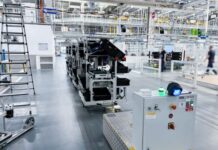A German research alliance has taken the next step in car front lighting with a 1,024 pixel LED for matrix headlights.
Matrix headlights are effectively projectors, capable of sending individual beams of light in front of the vehicle an, in conjunction with cameras and algorithms, allowing the parts of the beam that would dazzle on-coming drivers to be turned off dynamically.
The demonstration model was developed Osram, Daimler, Fraunhofer, Hella and Infineon.
In this case, both headlights contain three LED light sources, each with 1,024 individually controllable pixels – 3,072 pixels per headlight.
“This means that the headlight can be adapted very precisely to suit the respective traffic situation to ensure optimum light conditions at all times without dazzling other drivers,” said Osram. “The light can be adapted to take account of every conceivable bend in the road so that there are no dark peripheral areas.”
Surroundings can be analysed in order to illuminate on-coming traffic so the driver sees it more clearly, without light being shone on the heads of the drivers in those vehicles. “As a result, such shifting headlights no longer have to be dimmed [dipped] on country roads,” said Osram.
The project, funded by the German Federal Ministry of Education and Research (BMBF) lasted three and a half years.
The LED chip used includes led switching via a bonded die (see below), and this chip is included in a module created by Osram Specialty Lighting that has electrical and thermal interfaces for the vehicle.
Processing includes knowledge of driving and weather conditions, said Osram, and answers the questions: What is the course of the road? How fast is the car driving? Is there oncoming traffic? What is the distance between the car and other vehicles?
“Based on these conditions, the variable, adaptive light distribution ensures tailor-made lighting in every situation,” said Osram.
For example, at high speeds, the range of the light beam is increased automatically.
In city traffic, wider light distribution illuminates road, pavement and peripheral areas.
“We now want to develop this new type of high-resolution LED light sources so that it’s ready for serial production and we see enormous potential for its use in headlights,” said Osram CTO Stefan Kampmann.
Infineon developed the intelligent driver circuitry to connected directly to the LED array above it.
Headlight maker Hella specified the main technical requirements for the light source based on the functional requirements from Daimler – A Daimler vehicle was used for road trials.
Already, some Mercedes-Benz E-Class have 84 LED multi-beam headlights, made by Hella with Osram LEDs.
Bonded die
Fraunhofer IMZ contributed techniques and materials for the fine-grain connection technology between LED and switching IC. “With extremely good cooling, the chips were assembled to enable micrometer-sized height differences to be balanced out,” said Osram.
Two different assembly techniques were investigated: thermocompression bonding with porous gold nano-sponge and reflow soldering with highly reliable gold-tin. Both worked, with high yield, claimed Osram. “One of the technological challenges of the high-resolution LED headlight is the comparatively large chip with 1,024 individually controllable pixels.” – as die size increases, it raises the risk of dead or dim pixels in the matrix during the production.
To overcome this Fraunhofer IAF developed a technique based on ultraviolet laser micromachining to repair LED defects during the production process.
Defects are identified and removed with a UV laser through careful material removal, or are electrically isolated without the laser causing additional leakage paths. When they have been repaired, apparently the pixels regain their full luminosity.
“The economic benefits of laser micromachining from the Fraunhofer IAF are not only in reducing defects during production, the process can also increase the average life of the LEDs,” said Osram














